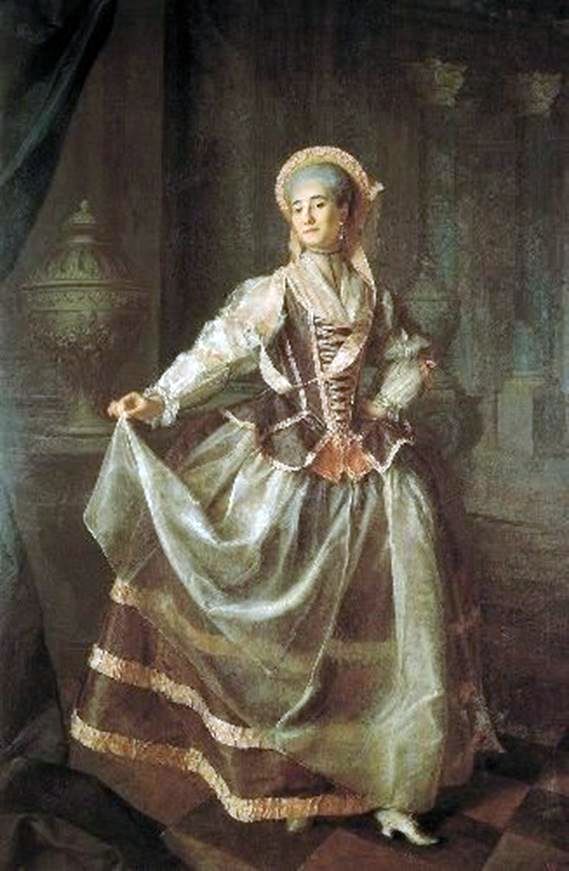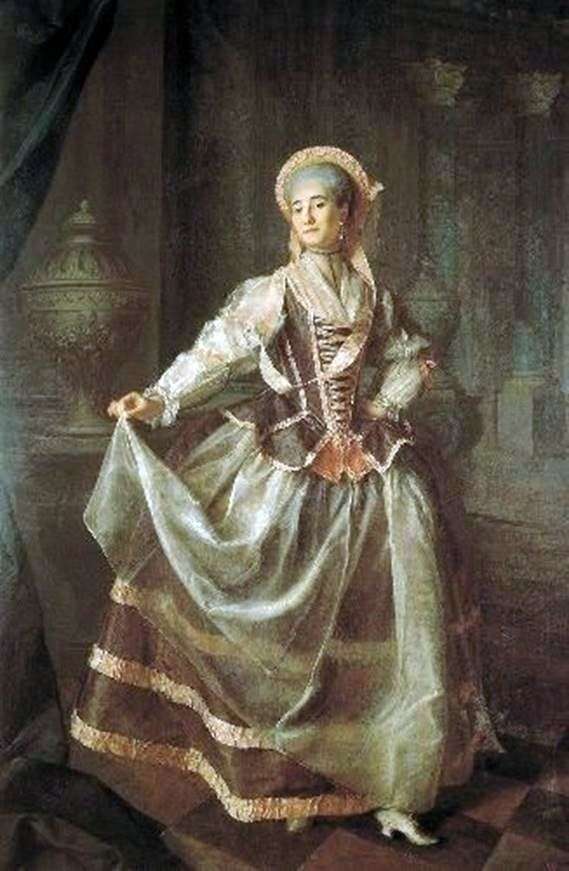
The image of Alexandra Levshina stands somewhat apart in the series of portraits of the Smolnyans, although her portrait was executed with no less skill than all the rest. Levshina in a magnificent theatrical dress stopped in a dance among the luxurious palace furnishings.
The texture of the fabrics, picturesquely united in a creamy-pink, ash-dull tone, is well read; accurately transferred graceful movement. In this portrait, the visible melody of the dance gesture and exquisite decorative painting are complemented by the expressive influence of light and shadow.
However, the face of a seventeen-year-old girl seems to be over the years to adults: slightly tilted in accordance with the dance pose, lit by a benevolent smile, it is filled with seriousness and attention, black shiny eyes are looking down relentlessly and aloof. The discrepancy between “external” and “internal” is clearly noticeable. Smooth gestures and posture of Levshin, who seem to be more likely to fit a more mature person, gently plow open the spatial-spatial composition of the picture before us.
With his right hand, Levshin lifts and sets aside the edge of the already very wide skirt, filling the dark space of the deep background. The left arm and shoulder bent at the elbow are somewhat retracted – with this technique the artist connects the frontal part of the picture and its backdrop. Portraits of Molchanova, Borshchova and Alymova constitute a separate compositional unity. Judging by the size of the canvases and their compositional solution, from the very beginning they were conceived as something whole: in the center – standing Borschov, on the sides – sitting Molchanov and Alymova facing each other. The draping of the magnificent satin skirts, the very position of the figures, a similar turn to the viewer of slightly smiling faces, the movements of the hands create a clearly readable closed composition.
Weighted by the dark folds of the curtain at Molchanova’s left, while at Alymova, respectively, the right side of the background is contrasted by the gold of the fingerboard of the harp and the physical instrument. In turn, these light spots prepare the viewer’s eye for a deep breakthrough of the background in Borshchova with the stairs going down. Compositionally related to each other, trappings should solve a common semantic problem. As is commonly believed, they represent an allegory of recitation, dance and music.
 Portrait d’un élève de la société éducative impériale des jeunes filles nobles Alexandra Levshina – Dmitry Levitsky
Portrait d’un élève de la société éducative impériale des jeunes filles nobles Alexandra Levshina – Dmitry Levitsky Retrato de un estudiante de la Sociedad Educativa Imperial de las Nobles Doncellas de Alexandra Levshina – Dmitry Levitsky
Retrato de un estudiante de la Sociedad Educativa Imperial de las Nobles Doncellas de Alexandra Levshina – Dmitry Levitsky Portrait of Glafira Ivanovna Alymova by Dmitry Levitsky
Portrait of Glafira Ivanovna Alymova by Dmitry Levitsky Portrait of Natalia Semenovna Borshchova by Dmitry Levitsky
Portrait of Natalia Semenovna Borshchova by Dmitry Levitsky Portrait of F. S. Rzhevskaya and A. N. Davydova (Smolyanka) by Dmitry Levitsky
Portrait of F. S. Rzhevskaya and A. N. Davydova (Smolyanka) by Dmitry Levitsky Portrait of the priest Peter Levitsky by Dmitry Levitsky
Portrait of the priest Peter Levitsky by Dmitry Levitsky Portrait of Catherine Ivanovna Molchanova by Dmitry Levitsky
Portrait of Catherine Ivanovna Molchanova by Dmitry Levitsky Portrait of M. A. Lvov by Dmitry Levitsky
Portrait of M. A. Lvov by Dmitry Levitsky